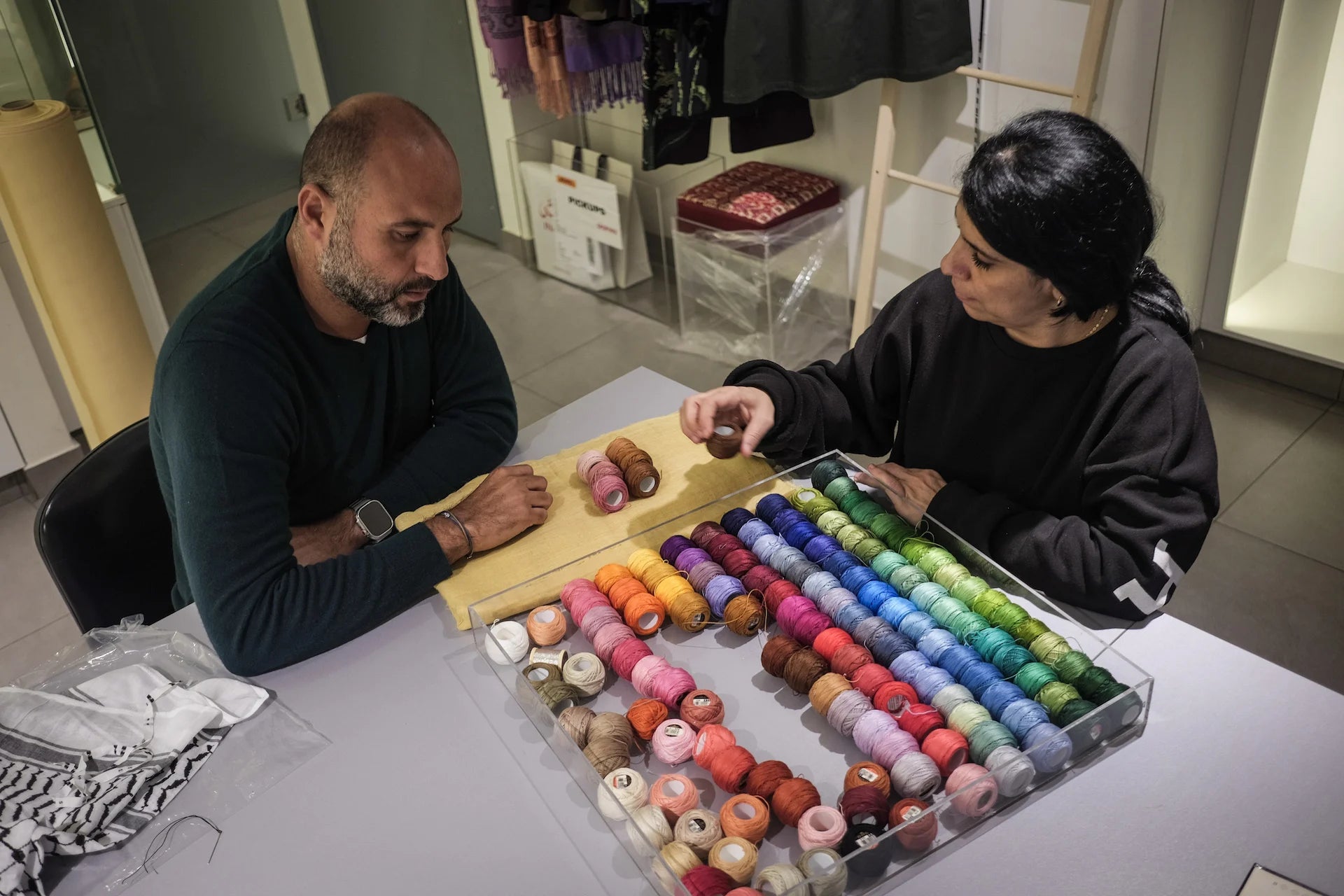For traditional Palestinian embroiderers, a quiet ‘resistance’ of art amid war
Tatreez embroidery has long been an important form of expression during hard times, each geometric motif representing a region of Palestine or part of its traditional life.
L'Orient Today / Malek Jadah, with photos by João Sousa, 19 March 2024 17:01

SHATILA CAMP, Beirut — In an NGO office in the Shatila Palestinian refugee camp just south of Beirut, two elderly women stand next to each other, holding up pieces of tatreez embroidery that they’ve been spending hours stitching by hand.
One of them is still making the final touches of the day while the other is preparing herself to go back home after working her two-hour daily shift.
Tatreez is a traditional Palestinian craft passed down through the generations, usually from woman to woman. Historically, it’s also been an important form of expression during challenging times, each geometric motif representing a specific region of Palestine or part of its traditional life.


Often worn at weddings, tatreez thobes — traditional dresses — can represent a woman’s village, reflecting the connection between her and her home in Palestine. The thobes remain beloved among Palestinian refugees and those in the Palestinian diaspora.
Symbol of Palestinian resistance
After Israel expelled tens of thousands of Palestinians from their homes during the Nakba in 1948 and the Naksa in 1967, wearing the thobes became a way to preserve culture. Embroidering them also became a form of Palestinian resistance and patriotism.
Sobhiye Krayem, 70 years old, lives in the Ain al-Hilweh Palestinian refugee camp just outside of Saida. She has taught tatreez in many different places over the course of her life. For her, Palestinian resistance against Israel is not necessarily only done with arms but through art as well. She still wears tatreez clothing when showing exhibitions of her work.



“Tatreez reflects the Palestinian resistance … we fight to show that tatreez is ours.”
The art is also gaining new provenance amid the war on Gaza, with more than 31,800 Palestinians killed by Israeli forces since Oct. 7.
Embroiderer Fathiye Charkiye was born in Lebanon, though her family originally comes from Amqa, a village near Akka in coastal northern Palestine. She has just finished her shift at the Social Support Society, an NGO in Shatila, one morning in February when L’Orient Today finds her working on a colorful rectangle of tatreez.
When she was a girl, nobody formally taught Charkiye the art of tatreez. Instead, she used to sit outdoors near her house in the Shatila camp and simply watch other women doing it.


“A long time ago the camp’s streets were not like this, there was space between houses for women to sit and work,” she says, speaking to the tight, narrow alleyways of Shatila today.
Back then there were no sewing needles available. “We used to use iron from umbrellas and transform them into needles,” she says.
Though Charkiye stopped doing tatreez for several decades, she picked it up again six months ago when she joined the Social Support Society as a tatreez artist.
Making an income
Em Hani was born in Lebanon more than 70 years ago. She sits next to Charkiye at the Social Support Society in Shatila, fully focused on stitching her tatreez piece, though speaks between stitches.
“I have been doing tatreez for 40 years, it is a source of income,” Em Hani says.
“My husband is dead, I do not have someone who can provide for me.” Instead, she adds, “I provide for myself and I mainly focus on tatreez.”
Lebanese labor laws restrict Palestinian refugees from most skilled, white-collar professions, with manual and informal jobs left over for grabs.


Located near Adonis Street in Ras Beirut, Inaash is an NGO and embroidery atelier that preserves Palestinian heritage through hand-made tatreez. The workers are almost all Palestinian women who live in refugee camps in Lebanon. With a workshop located near the office, Inaash’s showroom is adorned with a mixture of traditional as well as modern tatreez clothing designs. In coordination with the artistic platform Dar Onboz, Inaash has also delivered two tatreez classes in recent weeks.
Ali Jaafar, manager of Inaash, says the organization is helping women from Palestinian refugee camps in Lebanon support their households.
Since 1969, the year Inaash opened, “we have supported more than 2,000 women in the camps,” Jaafar says. Today Inaash employs around 350 tatreez embroiderers, all of them women, he adds.
“This is how [Palestinian refugees] sustain their life, this is how they support their families, this is how they pay for food.”


According to Jaafar, interest in Palestinian tatreez has grown since the start of the Gaza war on Oct. 7. The war has seen Israeli forces brutally bomb the Gaza Strip, destroying Palestinian lives, homes and precious family heirlooms.
“Inaash found that a lot of people are interested, especially with what's going on now, to learn this art … now we are planning to open more classes,” Jaafar says.
“We got more customers [after the war], people want to know and buy more.”
Steps away, in Inaash’s workshop, two Palestinian women and a Lebanese woman sit together in calm silence sewing tatreez. “We are ready to work until we die but the only problem is that [the physical demands of the job] hurt our backs. I have been working here for 22 years and working, in general, in embroidery for 34 years,” says Iman, an elderly Palestinian woman embroidering with colorful threads.
“We will teach the new generation,” Dalal, one of them, says. “Palestinians do not become tired,” Iman adds.
“As long as we breathe, we are going to work.”

